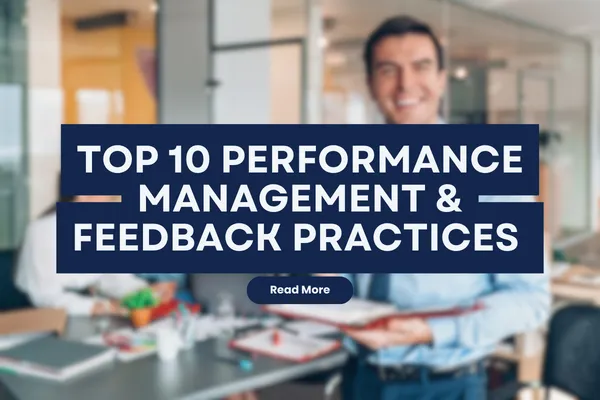Client Pro Blogs
Get Unlimited Leads With 'AI'
Download Our Free Ebook

Top 10 Performance Management & Feedback Practices
Introduction
Performance management and feedback practices are integral to the success and growth of any organization. To excel in this area and outrank other websites, we've compiled a through guide to the top 10 performance management and feedback practices.

1. Setting Clear Objectives
Effective performance management begins with setting clear and achievable objectives. Start by defining SMART (Specific, Measurable, Achievable, Relevant, Time-bound) goals for your employees. This not only provides a clear direction but also allows for easy measurement of progress.
2. Regular Check-Ins
Regular check-ins, a cornerstone of effective performance management, play a crucial role in fostering communication and ensuring everyone in the organization is on the same page. These check-ins involve frequent, informal conversations between employees and their managers. They provide an opportunity to build rapport, address concerns, and offer feedback in a timely manner.
Regular check-ins are not limited to discussing work-related matters but also involve understanding employees' personal goals and challenges, creating a holistic picture of their well-being within the organization. This practice helps employees feel heard and valued, contributing to their job satisfaction and motivation. Additionally, it allows managers to monitor progress, identify areas for improvement, and make necessary adjustments in real-time. By implementing regular check-ins, organizations can strengthen employee-manager relationships, enhance performance, and ultimately achieve their objectives more effectively.
3. 360-Degree Feedback
360-degree feedback, also known as multi-rater feedback, is a valuable practice in performance management. It involves gathering input on an employee's performance from various sources, including peers, managers, and subordinates. This holistic approach provides a more comprehensive view of an individual's strengths and areas for improvement. It fosters a culture of transparency, collaboration, and continuous growth within an organization.
In 360-degree feedback, employees receive feedback from different perspectives, helping them gain valuable insights into their performance. It allows them to identify blind spots and areas where they can excel further. This practice promotes open communication and teamwork as it encourages employees to share their thoughts and observations about each other's work.
360-degree feedback is a powerful tool for personal and professional development. It helps individuals set clear goals and work on enhancing their skills based on the feedback received. By implementing this practice, organizations can not only improve individual performance but also strengthen their overall team dynamics, ultimately leading to greater success and productivity.
4. Performance Metrics
Performance Metrics play a vital role in evaluating employee performance and driving organizational success. These metrics, also known as Key Performance Indicators (KPIs), are essential tools in performance management. They provide a quantifiable way to measure and track how well employees are doing in their roles.
By setting clear and relevant metrics aligned with the company's objectives, organizations can effectively monitor progress and identify areas for improvement. For example, sales teams may use metrics such as revenue generated or customer satisfaction scores, while manufacturing teams might focus on metrics like production efficiency or defect rates.
These performance metrics provide valuable insights into individual and team performance, helping managers make informed decisions and set achievable goals. Regularly reviewing and analyzing these metrics ensures that employees stay on track, and any necessary adjustments can be made promptly. Overall, performance metrics are indispensable tools in achieving and maintaining peak performance within an organization.
5. Constructive Feedback
Constructive feedback plays a pivotal role in employee growth and organizational success. It's all about offering guidance and support to help individuals improve their performance. In a workplace setting, constructive feedback typically follows the "sandwich" approach—beginning with positive reinforcement, addressing areas for improvement, and concluding with encouraging words. This approach ensures that feedback is well-received and motivates employees to strive for excellence.
When providing constructive feedback, it's essential to focus on specific behaviors or actions rather than making personal judgments. By pinpointing areas where improvement is needed and offering concrete suggestions for enhancement, employees are more likely to understand and act upon the feedback. This leads to professional development and contributes to a positive work environment where employees feel valued and supported.
Ultimately, constructive feedback is a powerful tool for fostering continuous improvement, enhancing employee performance, and driving overall success within an organization. It's a practice that not only helps individuals reach their full potential but also contributes to the achievement of organizational goals.
6. Employee Development Plans
Employee Development Plans are essential tools in nurturing the growth and potential of your workforce. These plans, tailored to individual employees, serve as roadmaps for personal and professional development. In a semi-formal tone, let's delve into the significance of these plans.
Employee Development Plans allow organizations to identify and harness the unique strengths and weaknesses of their employees. By understanding these traits, companies can provide targeted training and resources, helping employees enhance their skills and contribute more effectively. This not only benefits the individual but also adds value to the organization as a whole.
These plans play a pivotal role in fostering a culture of continuous improvement. They encourage employees to set clear goals and objectives, aligning their efforts with the company's mission. This alignment promotes a sense of ownership and commitment among employees.
7. Recognition and Rewards
Recognition and rewards play a pivotal role in the world of performance management. When employees' hard work and dedication are acknowledged and appreciated, it not only boosts their morale but also motivates them to excel even further.
In a semi-formal context, it's essential to create a workplace culture where achievements, both big and small, are celebrated. This can be done through verbal praise, certificates, or even tangible rewards like bonuses or gift cards.
When employees feel valued and recognized for their contributions, they are more likely to stay engaged, committed, and satisfied in their roles. It's a win-win situation for both employees and the organization.
Recognition and rewards should be timely, specific, and aligned with the company's values and goals. By incorporating this practice into your performance management strategy, you'll not only boost team morale but also enhance overall productivity and job satisfaction, helping your organization thrive in today's competitive business environment.
8. Training and Development
Training and Development is a critical component of ensuring that employees can excel in their roles and contribute effectively to an organization's success. This practice involves equipping employees with the necessary skills and knowledge to perform their tasks efficiently and stay updated with industry trends. It goes beyond just initial onboarding; it encompasses continuous learning throughout an employee's journey.
By investing in training and development programs, companies empower their workforce to grow and adapt to changing demands. This not only benefits individual employees but also enhances the overall productivity and competitiveness of the organization.
Training and Development initiatives can include workshops, online courses, mentorship programs, and access to valuable resources. These opportunities help employees acquire new skills, improve existing ones, and foster a culture of ongoing learning. In a semi-formal tone, it is evident that organizations that prioritize Training and Development are better equipped to tackle challenges, innovate, and stay ahead in the ever-evolving business landscape.
9. Continuous Improvement
Continuous improvement is a fundamental practice in modern organizations that focuses on making consistent, incremental enhancements in various aspects of operations. It involves an ongoing commitment to identifying areas for enhancement and implementing changes to drive better results.
This approach fosters a culture of adaptability and innovation within the workplace. By encouraging employees to share their ideas and suggestions for improvement, organizations can tap into their collective knowledge and experience.
Continuous improvement not only enhances efficiency but also results in higher quality products or services and increased customer satisfaction. It's like a journey where every step forward counts, no matter how small. By making incremental progress and refining processes over time, organizations can stay competitive, adapt to changing market conditions, and achieve long-term success. In essence, continuous improvement is about always striving to be better and ensuring that every day is an opportunity for growth and progress.
10. Performance Reviews
Performance reviews are a vital component of effective performance management. These regular evaluations provide a structured way to assess an employee's work, offering valuable feedback and setting the stage for future goals. They serve as a culmination of the feedback and data collected throughout the year, ensuring fairness and consistency in assessing performance.
Performance reviews provide an opportunity for open and constructive dialogue between employees and managers, facilitating better communication and understanding. During these reviews, strengths are acknowledged, areas for improvement are addressed, and new objectives are set, aligning the individual's efforts with the organization's goals.
This process helps employees track their progress, identify areas where they can grow, and receive recognition for their contributions. In a semi-formal tone, performance reviews play a pivotal role in fostering a culture of continuous improvement, motivating employees, and ensuring that everyone is working towards the same objectives.
In conclusion, effective performance management and feedback practices are pivotal to an organization's success. By implementing these top 10 practices, you can ensure that your workforce is engaged, motivated, and aligned with your company's goals. This comprehensive guide will help you not only outrank other websites but also excel in performance management and feedback within your organization.
Let’s get you growing. Without the growing pains.
Let’s get you growing. Without the growing pains.
Contact Us
Easily Integrates With Leading Apps





About Client Pro
Culture
Compare Client Pro
Customer stories
Products
Features
All features
Appointments
Automation
CRM
Ecommerce & payments
Email marketing
Integrations
Landing pages & forms
Lead management
Reporting & analytics
Sales pipeline
Text marketing
Resources
Events
What is a CRM?
Lifecycle Automation
LCA Assessment
Free email templates
Subject Line Generator
How-to guides
Blog
Partners
Find a partner!
Apps & integrations
Help & Support
New customer resources
Customer Support
Help center!
Training Academy
Client Pro Marketplace
Play & template library!
Culture
Compare ClientPro
Customer stories
Contact us
Features
All features
Appointments
Automation
CRM
Email marketing
Text marketing
Sales Pipeline
Integrations
Payments & Invoicing
Websties & Landing pages
Lead management
Reporting & analytics
Products
Basic
Pro
AI Agent
Resources
Events
Automation
Free email templates
How-to guides
Blog
Help & Support
Customer Support
Help center
Client Pro Training Academy
Marketplace
Data migration
Coaching & guarantee
Product updates
Partners
Become a partner
Partner portal
Apps & integrations



